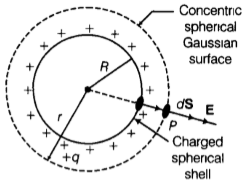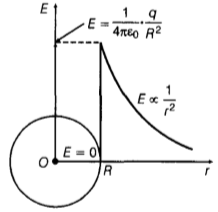Ask questions which are clear, concise and easy to understand.
Ask QuestionPosted by Kushagra Singh 4 years, 5 months ago
- 2 answers
Posted by Suhani Rana 4 years, 5 months ago
- 1 answers
Ashvin Govil 4 years, 5 months ago
Posted by Zen Ch 4 years, 5 months ago
- 0 answers
Posted by Hema Gautam 4 years, 5 months ago
- 1 answers
Preeti Dabral 4 years, 5 months ago
Electric Field of Point Charge. The electric field of a point charge Q can be obtained by a straightforward application of Gauss' law. Considering a Gaussian surface in the form of a sphere at radius r, the electric field has the same magnitude at every point of the sphere and is directed outward. Let us consider charge +q be uniformly distributed over a spherical shell of radius R. Let E is to be obtained at Plying outside of spherical shell.
{tex}\because {/tex} 'E' at any point is radially outward (if charge q is positive) and has same magnitude at all points which lie at the same distance r from centre of spherical shell such that r > R.
Therefore, Gaussian surface is concentric sphere of radius r such that r > R.

By Gauss' theorem
{tex}\oint \mathbf { E } \cdot d \mathbf { S } = \frac { q } { \varepsilon _ { 0 } } \Rightarrow \oint E d S \cos 0 ^ { \circ } = \frac { q } { \varepsilon _ { 0 } }{/tex}
[{tex}\because {/tex} E and dS are along the same direction]
{tex}E \cdot \oint d S = \frac { q } { \varepsilon _ { 0 } }{/tex} [{tex}\because {/tex} Magnitude of E is same at every point on Gaussian surface]
{tex}E \times 4 \pi r ^ { 2 } = \frac { q } { \varepsilon _ { 0 } }{/tex}
{tex}\Rightarrow \quad E = \frac { 1 } { 4 \pi \varepsilon _ { 0 } } \cdot \frac { q } { r ^ { 2 } }{/tex}
Now, graph

Variation of E with r for a spherical shell in which charge q is distributed over its surface which shows that electric field inside a spherical shell is zero.
Posted by Mayank Mathur 4 years, 5 months ago
- 1 answers
Ankit Kumar 4 years, 5 months ago
Posted by Harish Kumar 4 years, 5 months ago
- 3 answers
Sher Singh 4 years, 5 months ago
Akhilesh Chauhan 4 years, 5 months ago
Prachi Agarwal 4 years, 5 months ago
Posted by Honey Bissa23 4 years, 5 months ago
- 1 answers
Posted by Ayush Jaiswal 4 years, 5 months ago
- 0 answers
Posted by Tanvir Singh 😊😀😊 4 years, 5 months ago
- 5 answers
Posted by Dongar Suryawanshi 4 years, 5 months ago
- 0 answers
Posted by Vidya Hosagoudru 4 years, 5 months ago
- 1 answers
Sia ? 4 years, 5 months ago
Posted by Hadia Waqure 4 years, 5 months ago
- 5 answers
Akhilesh Chauhan 4 years, 5 months ago
Posted by Red ♥️ 4 years, 5 months ago
- 2 answers
Sher Singh 4 years, 5 months ago
Posted by Dinesh Kumar 4 years, 5 months ago
- 2 answers
Sia ? 4 years, 5 months ago
There are two laws as follows:
- Kirchhoff’s first law, also known as Kirchhoff’s current law (KCL) states that the current flowing into a node must be equal to the current flowing out of the node. This is a consequence of charge conservation.
- Kirchhoff’s second law, also known as the Kirchhoff’s voltage law (KVL) states that the sum of all voltages around a closed loop in any circuit must be equal to zero. This again is a consequence of charge conservation and also conservation of energy.
Bhumi Ka 4 years, 5 months ago
Posted by Sher Singh 4 years, 5 months ago
- 2 answers
Rohit Rathore 4 years, 5 months ago
Shreeya ? 4 years, 5 months ago
Posted by Mannu Arshan 4 years, 5 months ago
- 1 answers
Sia ? 4 years, 5 months ago
1 electron volt is the energy change that takes place when a charge equal to 1 electron (1.6×10-19C) is moved through a potential difference of 1 volt.
The eV Joule Conversion is very important in solving problems in physics. Below is the table of eV to Joule conversion-
| Energy in eV | Energy in joules |
| 1 eV | 1.60218×10-19 J |
| 2 eV | 3.2044 ×10-19 J |
| 3 eV | 4.8065×10-19 J |
| 4 eV | 6.4087×10-19 J |
| 5 eV | 8.0109×10-19 J |
| 6 eV | 9.6131×10-19 J |
| 7 eV | 1.1215×10-18 J |
| 8 eV | 1.2817×10-17 J |
| 9 eV | 1.442×10-18 J |
| 10 eV | 1.6022×10-18 J |
| 50 eV | 8.0109×10-18 J |
| 100 eV | 1.6022×10-17 J |
| 500 eV | 8.0109×10-17 J |
| 1000 eV | 1.6022×10-16 J |
Posted by Prangana Das 4 years, 5 months ago
- 1 answers
Sia ? 4 years, 5 months ago
The difference between crown and flint glass is how much they disperse or spread out the colors. Crown glasses have relatively low dispersion, while flint glasses have relatively high dispersions. It is the difference in dispersion that allows a crown and a flint to be combined to make an achromat. Glasses with big differences in dispersion work best, allowing relatively shallow curves and good control of aberrations.
Posted by Neeraj Kumar 4 years, 5 months ago
- 0 answers
Posted by Anushka Sinha 4 years, 5 months ago
- 1 answers
Posted by Nikku Ad 4 years, 5 months ago
- 1 answers
Sia ? 4 years, 5 months ago
Case 1 :- Let two charges 5 × 10⁻⁸C and -3 × 10⁻⁸C are placed on a line of points A answer B and C is the point where electric potential becomes zero.
e.g., A---------------C---------------B
Then, use =0
or,
or,
Let CA = x then, CB = (16 - x)
so, 9 × 10⁹ × 5 × 10⁻⁸/x + 9 × 10⁹ × (-3 × 10⁻⁸)/(16 - x) = 0
⇒ 5/x = 3/(16 - x)
⇒ 5(16 - x) = 3x
⇒ 80 - 5x = 3x
⇒ 80 = 8x
x = 10
Hence, electric potential is zero at the distance of 10cm from charge of 5 × 10⁻⁸C on line joining the two charges between them.
Case 2 :- Let C is not between the two charges. Then,
A-------------B------C
or,
or,
or, 5 × 10⁻⁸/(16 + x) + (-3 × 10⁻⁸)/x = 0
or, 5/(16 + x) = 3/x
or, 5x = 48 + 3x
or, 2x = 48 ⇒x = 24cm
So, electric potential is also equal to zero at distance of 24cm from charge of - 3 × 10⁻⁸C and at a distance of (24 + 16) cm from charge of 5 × 10⁻⁸C,on the side of charge of - 3 × 10⁻⁸C
Posted by Ayush Jaiswal Ayush Jaiswal 4 years, 5 months ago
- 3 answers
Hema Gautam 4 years, 5 months ago

myCBSEguide
Trusted by 1 Crore+ Students

Test Generator
Create papers online. It's FREE.

CUET Mock Tests
75,000+ questions to practice only on myCBSEguide app
 myCBSEguide
myCBSEguide
Sourav Verma_1919 4 years, 5 months ago
0Thank You